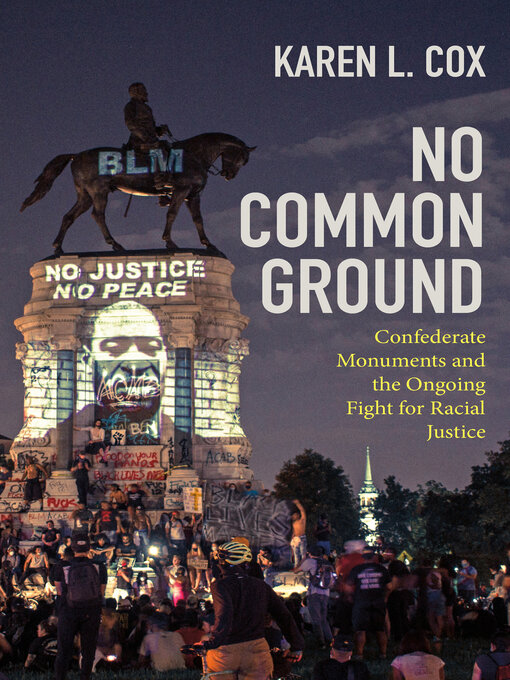- Fiction
- Nonfiction
- Biographies and Autobiographies
- Religion and Spirituality
- Politics
- Battle of the Books 2023
- RCCC Library Picks
- See all dogwood digital library's collections collections
No Common Ground
Confederate Monuments and the Ongoing Fight for Racial Justice
In this eye-opening narrative of the efforts to raise, preserve, protest, and remove Confederate monuments, Karen L. Cox depicts what these statues meant to those who erected them and how a movement arose to force a reckoning. She lucidly shows the forces that drove white southerners to construct beacons of white supremacy, as well as the ways that antimonument sentiment, largely stifled during the Jim Crow era, returned with the civil rights movement and gathered momentum in the decades after the Voting Rights Act of 1965. Monument defenders responded with gerrymandering and "heritage" laws intended to block efforts to remove these statues, but hard as they worked to preserve the Lost Cause vision of southern history, civil rights activists, Black elected officials, and movements of ordinary people fought harder to take the story back. Timely, accessible, and essential, No Common Ground is the story of the seemingly invincible stone sentinels that are just beginning to fall from their pedestals.
-
Creators
-
Series
-
Publisher
-
Release date
February 23, 2021 -
Formats
-
Kindle Book
- ISBN: 9781469662688
-
OverDrive Read
- ISBN: 9781469662688
-
EPUB ebook
- ISBN: 9781469662688
- File size: 8045 KB
-
-
Languages
- English
-
Reviews
-
Library Journal
Starred review from March 1, 2021
In her superb contribution to the history of the South, Cox (Dixie's Daughters) targets the massive influence of the United Daughters of the Confederacy (UDC) on Southerners in the late 1890s and beyond, especially in the area of monument building. According to the author, members were motivated not just to honor their veteran ancestors, but to vindicate them as well. Cox maintains that the UDC spent millions of dollars on statue projects, and that much of the money was appropriated from state and local governments. She argues that, while funding monuments and memorials and lobbying for their placement were critical aspects of the UDC's work in the early 20th century, its agenda looked toward the future as much as it commemorated the past. According to Cox, UDC advocates sought to ensure that future generations of white Southerners would hold up their Confederate ancestors as heroes and would themselves defend the same principles for which their forerunners fought, including an all-out defense of states' rights. VERDICT This is an invaluable study of all-too-frequently misplaced genealogical and regional venerations. Highly recommended for U.S., antebellum, Civil War, African American, and Southern historians and scholars, and for all readers.--John Carver Edwards, formerly with Univ. of Georgia Libs.
Copyright 2021 Library Journal, LLC Used with permission.
-
Kirkus
March 1, 2021
A chronicle of the effort to erect and protect or remove Confederate statues or other monuments. Cox, a historian of the American South, estimates that several hundred monuments to the Confederacy exist in cemeteries, town squares, and other public spaces, and many have faced political and legal challenges in recent years. In this engrossing social history, the author writes that while these memorials began with an impulse to remember the dead, the United Daughters of the Confederacy soon began using them to promote the so-called "Lost Cause" view that in the Civil War, the South fought not for slavery but for states' rights. Cox follows changes that have occurred since Reconstruction in the stances of friends and foes of the monuments, including Black activists whose opposition grew during the civil rights era and gained further momentum during recent protests centered on Confederate battle flags or statues of Robert E. Lee in cities such as Charleston, New Orleans, Charlottesville, and Richmond. The author argues that such monuments and symbols, like flags, are not harmless throwbacks: "They are weapons in the larger arsenal of white supremacy, artifacts of Jim Crow not unlike the 'whites only' signs that declared black southerners to be second-class citizens." For such reasons, Cox makes an implicit case for removing monuments from publicly funded spaces without reconciling that position with her view that monuments are "essentially, a local problem" and decisions about them should be made by "a cross-section of community stakeholders." She suggests no compromises that might work if residents of a community disagree on removal--there may be "no common ground" among people for whom monuments represent "competing visions of history." Nonetheless, this clear and thorough account, essential for Southern libraries, is likely to become a standard reference work on its subject. A well-documented history of Confederate monuments and the conflicting views they inspire.COPYRIGHT(2021) Kirkus Reviews, ALL RIGHTS RESERVED.
-
subjects
Languages
- English
Loading
Why is availability limited?
×Availability can change throughout the month based on the library's budget. You can still place a hold on the title, and your hold will be automatically filled as soon as the title is available again.
The Kindle Book format for this title is not supported on:
×- - Kindle 1
- - Kindle 2
- - Kindle 4
- - Kindle 5
- - Kindle 7
- - Kindle DX
- - Kindle Keyboard
- - Kindle Paperwhite
- - Kindle Touch
- - Kindle Voyage
Read-along ebook
×The OverDrive Read format of this ebook has professional narration that plays while you read in your browser. Learn more here.


